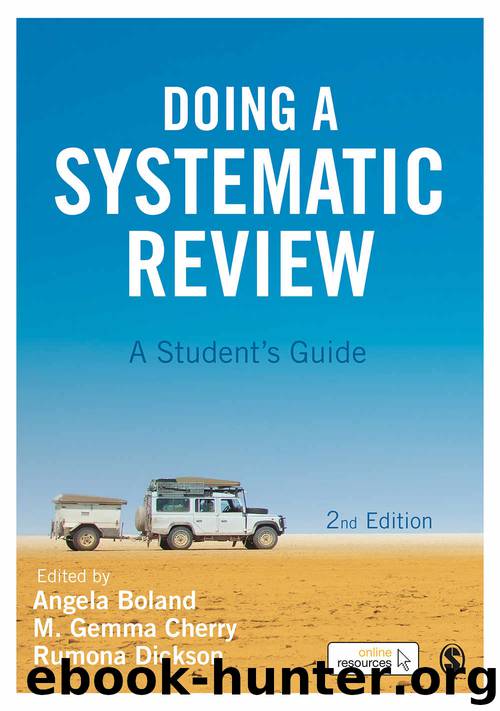Doing a Systematic Review: A Student's Guide by Angela Boland & Gemma Cherry & Rumona Dickson

Author:Angela Boland & Gemma Cherry & Rumona Dickson [Boland, Angela]
Language: eng
Format: azw3
Publisher: SAGE Publications
Published: 2017-10-09T04:00:00+00:00
Time-to-event data
Time-to-event (survival) data are outcomes that measure the time taken for each participant to experience an event from a specified starting point, for example, months of survival. For those who do not experience the event of interest during the time they are observed, the length of time that they are in the trial is still recorded and they are classed as ‘censored’.
It is possible to analyse time-to-event data in the same way as binary data by splitting patients into those who have experienced an event and those who have not experienced an event at a specific time period, but this requires knowledge of whether all patients have experienced the event or not at a given time point. The most common approach is to use survival analysis. This quantifies the data in terms of hazards, which are similar to risks (as mentioned in the binary data section) but are more unstable as they may change dramatically over time. Hazard ratios are interpreted in the same way as relative risks: a hazard ratio of 0.43 means that the risk of experiencing an event in one group is 43 per cent of the risk of experiencing an event in another group in a given time period.
Download
This site does not store any files on its server. We only index and link to content provided by other sites. Please contact the content providers to delete copyright contents if any and email us, we'll remove relevant links or contents immediately.
| Anthropology | Archaeology |
| Philosophy | Politics & Government |
| Social Sciences | Sociology |
| Women's Studies |
Cecilia; Or, Memoirs of an Heiress — Volume 1 by Fanny Burney(32434)
Cecilia; Or, Memoirs of an Heiress — Volume 2 by Fanny Burney(31871)
Cecilia; Or, Memoirs of an Heiress — Volume 3 by Fanny Burney(31854)
The Great Music City by Andrea Baker(31349)
We're Going to Need More Wine by Gabrielle Union(18967)
All the Missing Girls by Megan Miranda(15570)
Pimp by Iceberg Slim(14393)
Bombshells: Glamour Girls of a Lifetime by Sullivan Steve(13972)
Talking to Strangers by Malcolm Gladwell(13222)
Norse Mythology by Gaiman Neil(13205)
Fifty Shades Freed by E L James(13157)
For the Love of Europe by Rick Steves(12983)
Mindhunter: Inside the FBI's Elite Serial Crime Unit by John E. Douglas & Mark Olshaker(9200)
Crazy Rich Asians by Kevin Kwan(9167)
The Lost Art of Listening by Michael P. Nichols(7406)
Enlightenment Now: The Case for Reason, Science, Humanism, and Progress by Steven Pinker(7231)
The Four Agreements by Don Miguel Ruiz(6630)
Bad Blood by John Carreyrou(6552)
Weapons of Math Destruction by Cathy O'Neil(6143)
